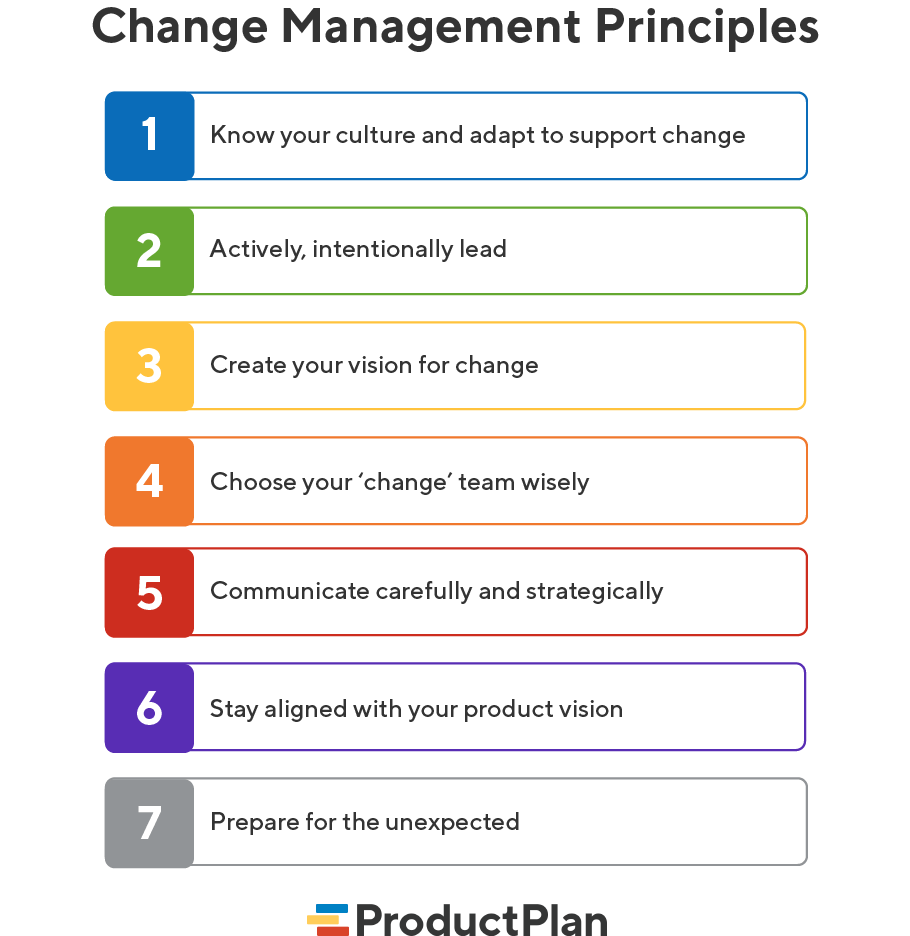What Are Change Management Principles?
Change management principles are the guiding practices business leaders should follow to effectively manage change, transitions, and disruptions within an organization. Changes may be internal (e.g., migrating to a new software platform) or external (e.g., new market opportunities, industry trends, or threats). Effectively managing these transitions by following the prescribed steps in the change management process increases success and adoption likelihood.

Why Are Change Management Principles Important?
Change is inevitable. Every description must accept this fact and develop strategies to help them manage and navigate either anticipated or unexpected transitions. How leaders and teams work these disruptions and changes directly impacts business outcomes (i.e., whether an organization thrives).
In the Gallup Workplace blog, Sherzod Odilov and Chris Musser explain:
“The kind of changes today’s organizations face are complex, far-reaching, and multidimensional, yet the most effective leaders navigate these changes by relying on proven principles. How organizations lead and manage change is what distinguishes companies that thrive from those that merely survive, or worse yet — fail.”
While change itself might be inevitable, a significant majority (close to 70%, in fact) of all change management initiatives fail. That’s why change management must be an intentional, strategic, well-coordinated effort. Organizations with an environment that supports change are more likely to experience smooth, successful transitions, reduced downtime during adjustments, and happier, more secure employees.
7 Key Change Management Principles for Success

Once you get comfortable with the notion that change is inevitable, you can put these 7 principles in place to set the stage for a successful transition.
Principle 1: Know your culture and adapt to support change.
Negative employee attitudes and organizational culture pose two of the most significant obstacles to successful change management. Does your team or organization foster an environment that supports change? Or do disruptions strike fear in the eyes of your employees? Change management can only be fruitful when born of a change culture. Think like a startup — encourage curiosity and experimentation. When hiring, build your team with a change mindset.
Principle 2: Actively, intentionally lead.
Leaders must lead effective change management, starting with C-level executives who need to take an active role by communicating, motivating, and being an inspiring role model throughout a transition. Think of it this way: You can either manage change or let change handle you.
Principle 3: Create a vision for change.
Establish a leadership vision that provides a sense of urgency and a rational need for change. Thoroughly investigate the “why” necessitating the change and provide concrete evidence. This will reassure employees resistant to change and go a long way in securing support and adoption.
Principle 4: Choose your ‘change’ team wisely.
Be strategic about who you involve and when in rolling out the change. Premature involvement and disorganized coordination will undermine your efforts. Identify key stakeholders (e.g., senior management and influential employees) with whom you will share a consistent message about the change and how it’s being addressed.
Principle 5: Communicate carefully and strategically.
Too much information can be overwhelming; too little information leads to gaps, breeds mistrust and misinformation. Communicate what is changing and anticipate what people will want to know, like how the change will affect them or what they will need to adjust to it. Make a clear case that explains why the change is necessary and work hard to manage expectations. The information you leave out will inevitably be filled in by imagination. Transparency will nurture trust.
Principle 6: Stay aligned with your product vision.
Change can be disruptive, but don’t allow it to push your team off course. Maintain close alignment with your product vision as the organization transitions.
Principle 7: Prepare for the unexpected.
Even with a carefully articulated approach to change management, there will always be surprises. Be flexible and stay vigilant in what these unexpected twists have to teach you. And read Jim Semick’s tips for embracing uncertainty.
Related terms: Change Management, Pivot, Product Ops, Product Vision, Product Leadership, Chief Product Officer
